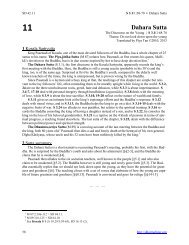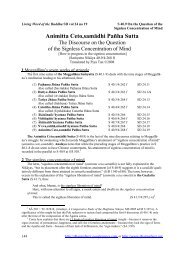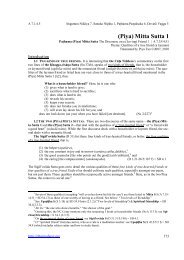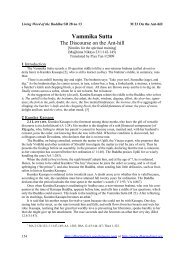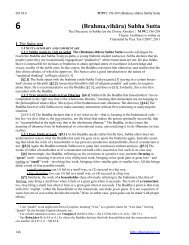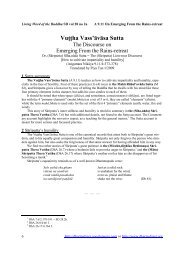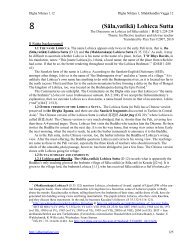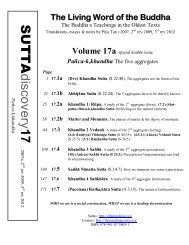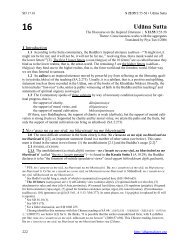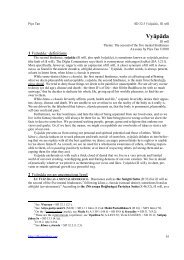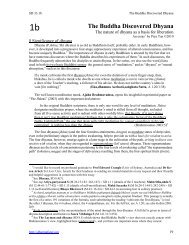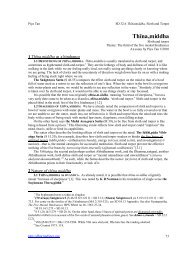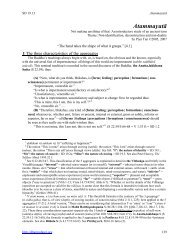Darukkhandha Sutta - The Dharmafarers
Darukkhandha Sutta - The Dharmafarers
Darukkhandha Sutta - The Dharmafarers
Create successful ePaper yourself
Turn your PDF publications into a flip-book with our unique Google optimized e-Paper software.
Living Word of the Buddha SD vol 28 no 5<br />
S 35.241 On the Log of Wood<br />
Dāru-k,khandha <strong>Sutta</strong> 1<br />
Paṭhama Dāru-k,khandha <strong>Sutta</strong> 1<br />
<strong>The</strong> First Discourse on the Log of Wood<br />
[Keeping to the middle way leads to liberation]<br />
(Saṁyutta Nikya 35.241/4:179-181)<br />
Translated by Piya Tan ©2006<br />
Introduction<br />
<strong>The</strong> Dāru-k,khandha <strong>Sutta</strong> 1 (S 35.241) is one of the most idyllic in its simplicity, similes and setting.<br />
<strong>The</strong> sutta theme is simply that of right living the holy life by keeping to the middle way (symbolized<br />
by the log’s continuous moving midstream) for the sake of awakening (reaching the great ocean). We are<br />
at once reminded of another similarly idyllic discourse, the Pheṇa,piṇḍa <strong>Sutta</strong> (S 22.95), similarly set on<br />
the Ganges bank, but at Ayodhya, where the Buddha, seeing some froth and bubbles, compared them to<br />
the five aggregates. 1<br />
<strong>The</strong> Dāru-k,khandha <strong>Sutta</strong> similes are graphically clear in conveying their spiritual significance, explained<br />
by the Buddha himself, as follows:<br />
Imagery<br />
“this bank”<br />
“the far shore”<br />
“sinking midstream”<br />
“caught on a sandbank”<br />
“being seized by humans”<br />
“being seized by non-humans”<br />
“seized by a whirlpool”<br />
“being rotten internally”<br />
Interpretation<br />
the six internal sense-bases,<br />
the six external sense-objects,<br />
lust and desire,<br />
the “I am” conceit,<br />
socializing with the laity to the neglect of one’s practice,<br />
living the spiritual life for the sake of heavenly birth,<br />
the five cords of sense-pleasures, 2 and<br />
living the religious life falsely.<br />
<strong>The</strong> beauty of such similes is this simplicity, aptness and integrity: there is a clear connectedness amongst<br />
the component images. <strong>The</strong> key image is the log, but there are also water and movement imageries. As<br />
long as there is clear direction and effort in the spiritual life, we gain the goal in due course.<br />
“A certain monk” asks the Buddha to explain the imagery. He could be any of us who has yet to<br />
understand the parable and be moved into greater effort in our spiritual life. <strong>The</strong> sutta concludes with a<br />
layman, a humble cowherd (gopalaka) (an eavesdropper, as it were), who is immediately inspired to<br />
renounce the world. So moved is he by the parable, that he wishes to renounce at once. <strong>The</strong> Buddha, however,<br />
reminds him to settle his worldly affairs first, that is, return the cows to their owners, that is, it is<br />
time to “count his own cows” now (Dh 19).<br />
<strong>The</strong> Dāru-k,khandha <strong>Sutta</strong> 2 (S 35.241) is identical to the Dāru-k,khandha <strong>Sutta</strong> 1 up to §12, except<br />
for two points. Firstly, the questioner is the monk Kimbila. Secondly, in §12, “being rotten internally”<br />
(anto,pūti) is defined in Vinaya terms, and end right there. In both cases, the Buddha is addressing his<br />
teachings to the monks, and it is on the scenic Ganges bank, and in the first <strong>Sutta</strong> we can easily visualize<br />
the cowherd and his cows, nearby. It is an idyllic setting worthy of reflecting on before a sitting meditation.<br />
— — —<br />
1 Form is compared to a great lump of froth, feeling to a water-bubble, perception to a mirage, mental formations<br />
to a large plantain tree, and consciousness to a magical illusion. (S 22.95/3:140-143) = SD 17.12.<br />
2 Cf Ūmi,bhaya S (A 4.122), where a more detailed def and admonition is given. (A 4.122/2:123-126) = SD<br />
47.9.<br />
48<br />
http://dharmafarer.googlepages.com or http://www.dharmafarer.org
Sayutta Nikya vol 4 S 35.241 Dāru-k,khandha <strong>Sutta</strong> 1<br />
<strong>The</strong> First Discourse on the Log of Wood<br />
(S 35.241/4:179-181)<br />
1 At one time the Blessed One was staying on the bank of the Ganges near Kosambī.<br />
<strong>The</strong> parable of the great log of wood<br />
2 <strong>The</strong> Blessed One saw a great log of wood being carried along by the Ganges river current. Seeing<br />
this, he addressed the monks:<br />
“Bhikshus, do you see that great log of wood being carried along by the Ganges river current?”<br />
“Yes, bhante.”<br />
3 If, bhikshus, that log of wood,<br />
does not land on this bank,<br />
na orimaṁ tīraṁ upagacchati,<br />
does not land on the far shore,<br />
na pārimaṁ tīraṁ upagacchati,<br />
does not sink midstream,<br />
na majjhe saṁsīdissati,<br />
does not get caught on a sandbank [high ground], na thale ussīdissati,<br />
is not seized [hauled up] by humans,<br />
na manussa-g,gāho gahessati,<br />
is not seized [hauled up] by non-humans, na amanussa-g,gāho gahessati,<br />
is not seized by a whirlpool,<br />
na āvaṭṭa-g,gāho gahessati,<br />
is not rotten internally,<br />
na anto,pūti bhavissati,<br />
then, bhikshus, that log of wood would tend towards the ocean, slant towards the ocean, slope towards the<br />
ocean.<br />
What is the reason for that?<br />
Because, bhikshus, the Ganges river current tends towards the ocean, slants towards the ocean, slopes<br />
towards the ocean.<br />
Even so, bhikshus,<br />
if you do not land on this bank,<br />
if you do not land on the far shore,<br />
if you do not sink midstream,<br />
if you are caught on a sandbank [high ground],<br />
if you are not seized by humans,<br />
if you are not seized by non-humans,<br />
if you are not seized by a whirlpool,<br />
if you are not rotten internally, [180]<br />
then, bhikshus, you would tend towards nirvana, slant towards nirvana, slope towards nirvana.<br />
What is the reason for that?<br />
Because, bhikshus, right view tends towards nirvana, slants towards nirvana, slopes towards nirvana.<br />
<strong>The</strong> parable explained<br />
4 When this was said, a certain monk said this to the Blessed One:<br />
“What now, bhante, is ‘this bank,’<br />
what is ‘the far shore,’<br />
what is ‘sinking midstream,’<br />
what is ‘caught on a sandbank,’<br />
what is ‘seized by humans,’<br />
what is ‘seized by non-humans,’<br />
what is ‘seized by a whirlpool,’<br />
what is ‘rotting internally’?”<br />
5 “‘This bank,’ bhikshu, this is a designation for the six internal sense-bases.<br />
6 ‘<strong>The</strong> far shore,’ bhikshu, this is a designation for the external sense-bases.<br />
7 ‘Sinking midstream,” bhikshu, this is a designation for lust and desire.<br />
http://dharmafarer.googlepages.com or http://www.dharmafarer.org 49
Living Word of the Buddha SD vol 28 no 5<br />
S 35.241 On the Log of Wood<br />
8 ‘Caught on a sandbank,’ bhikshu, this is a designation for the ‘I am’ conceit.<br />
9 And what, bhikkhu, is ‘seized by humans’? Here, bhikshu, he lives associating with laypeople—<br />
he rejoices with them, he sorrows with them. He is happy when they are happy, and sad when they are<br />
sad. He involves himself in their current affairs and duties as if they were his own. 3 It is in such a way that<br />
he is intimate with the village. 4<br />
This, bhikshu, is called ‘seized by humans.’<br />
10 And what, bhikkhu, is ‘seized by non-humans’? Here, bhikshu, a certain person lives the holy<br />
life aspiring for rebirth in one of the groups of devas, thinking, ‘By this rule or vow or austerity or holy<br />
life, I shall become a deva or one amongst them.’ 5<br />
This, bhikshu, is called ‘seized by non-humans.’<br />
11 ‘Seized by a whirlpool’, bhikshu, this is a designation for the five cords of sense-pleasures. 6<br />
12 And what, bhikkhu, is ‘being rotten internally’? 7 Here, bhikshu, a certain person is immoral,<br />
evil by nature, impure, of suspicious behavior, given to concealed deeds, a false ascetic claiming to be an<br />
ascetic, [181] not celibate, claiming to be celibate [a brahmachari], rotten internally [rotten to the core],<br />
drenched in lust, filthy. 8<br />
This, bhikshu, is called ‘rotting internally.’”<br />
Nanda the cowherd<br />
13 Now at that time, Nanda the cowherd was standing not far from the Blessed One.<br />
14 <strong>The</strong>n Nanda the cowherd said this to the Blessed One:<br />
“Indeed, bhante,<br />
I will not land on this bank,<br />
na orimaṁ tīraṁ upagacchāmi,<br />
I will not land on the far shore,<br />
na pārimaṁ tīraṁ upagacchāmi,<br />
I will not sink midstream,<br />
na majjhe saṁsīdissāmi,<br />
I will not be caught on a sandbank [high ground], na thale ussīdissāmi,<br />
no humans will seize me,<br />
na maṁ manussaggāho gahessati,<br />
no non-humans will seize me,<br />
na amanussaggāho gahessati,<br />
no whirlpool will seize me,<br />
na āvaṭṭaggāho gahessati<br />
I will not be rotten internally!<br />
na antopūti bhavissāmi.<br />
Bhante, may I receive the going forth before the Blessed One, may I receive the ordination.”<br />
15 “In that case, Nanda, return the cows to the owners.”<br />
“<strong>The</strong> cows will go back, bhante, out of attachment to their calves.”<br />
3 Such intimacy with the laity is considered unbecoming and unskillful of a monastic. See Nga,datta S (S 9.7/<br />
1:200 f) & Dru-k,khandha S 1 (S 35.241/4:180); also A 3:116 f. <strong>The</strong> phrase samna,sukha,dukkha (“same in joy<br />
and sorrow”) (D 3:187; S 1:201) is exemplified in a negative sense at Hliddakni S 1 (S 22.3.18/3:11), but in<br />
Sigl’ovda S, it has a positive sense, characteristic of a true friend (D 31.21/3:187): see SD 3.16.<br />
4 Also at Hāliddakāni S 1 (S 33.2.18/3:11); see UA 232; ThaA 3:69; NmA 1:25; cf KhpS 243..<br />
5 Api ca kho aññataraṁ deva,nikāyaṁ paṇīdhāya brahma,cariyaṁ carati iminā’haṃ sīlena vā vatena vā tapena<br />
vā brahma,cariyena vā devo vā bhavissāmi dev’aññataro vā ‘ti. Comy: That is, he wishes to become a deva,rajah or<br />
a deva,putra (lesser celestial being) (AA 4:32). <strong>The</strong> whole passage is stock: see D 3:239; M 1:102; S 4:180; A 4:18;<br />
cf A 9.72/4:459.<br />
6 Cf Ūmi,bhaya S (A 4.122), where a more detailed def and admonition is given. (A 4.122/2:123-126) = SD<br />
47.9.<br />
7 <strong>The</strong> answer is given in Vinaya terms, and the sutta then ends with the section of “Nanda the cowherd.”<br />
8 Idha, bhikkhu, ekacco dussīlo hoti pāpa,dhammo asuci,saṅkassara,samācāro paṭicchanna,kammanto assama-<br />
ṇo samaṇa,paṭiñño abrahmacārī brahmacāri,paṭiñño anto,pūti avassuto kasambu,jāto. Comy says that people will<br />
remember his deed with suspicion, or he recalls others with suspicion, and when seeing people talking amongst<br />
themselves, he suspects they must be discussing his faults. He is “filthy,” ie, refuse-like, on account of his defilements,<br />
such as lust, etc, (SA 3:42). As at (Samudda) Uposatha S 2 (A 8.20/239 f = U 5.5/52, 55), Aggi-k,khandhôpama<br />
S (A 7.68/4:128), Pahārāda S (A 8.19/4:201); see also DA 1:122; SA 3:42; AA 2:177, 4:64; UA 297;<br />
DhkA 207; Nm 483 :: NmA 455, 338.<br />
50<br />
http://dharmafarer.googlepages.com or http://www.dharmafarer.org
Sayutta Nikya vol 4 S 35.241 Dāru-k,khandha <strong>Sutta</strong> 1<br />
“Now, Nanda, return the cows to the owners.”<br />
<strong>The</strong>n Nanda the cowherd, having returned the cows to the owners, approached the Blessed One, and<br />
said this to the Blessed One:<br />
“<strong>The</strong> cows, bhante, have been returned to the owners. Bhante, may I receive the going forth before<br />
the Blessed One, may I receive the ordination.”<br />
Nanda the cowherd received the going forth before the Blessed One, and received the ordination.<br />
<strong>The</strong>n, Nanda the cowherd, not along after he was ordained, dwelling alone, aloof, diligent, exertive,<br />
and resolute, having right here and now realized it for himself through direct knowledge, attained and<br />
dwelled in that supreme goal of the holy life, for the sake of which sons of family rightly go forth from<br />
the household life into homelessness.<br />
He directly knew: “Birth is destroyed, the holy life has been lived, done what had to be done, there is<br />
no more of this state of being.” 9<br />
16 And the venerable Nanda became one of the arhats.<br />
— evaṁ —<br />
090408; 090502; 090802 DS; 091203<br />
9 On this para and the next (the attainment of arhathood), see Poṭṭhapāda S (D 9.56b/1:203) n = SD 7.14.<br />
http://dharmafarer.googlepages.com or http://www.dharmafarer.org 51



